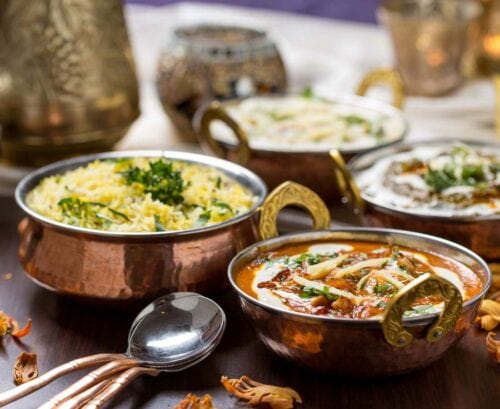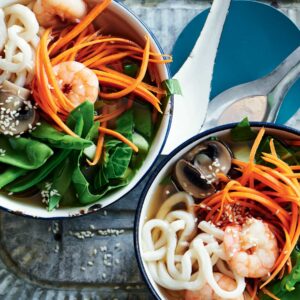
Chef Anjula Devi shares how she gets more flavour and uses less saturated fat and salt when she cooks her favourite Indian recipes
1. Bake rather than fry
Try baking samosas instead of frying them. I also make muffin-style pakoras that are baked rather than fried – the recipe is available in my book, Spice for Life.
2. Ditch the naans for chapattis
Make your own chapattis using wholemeal flour. ‘Rotis’, as we call them at home, are much lighter and lower in kilojoules/calories than naans, which are often served in restaurants with overwhelming amounts of ghee.
3. Bulk up dishes with lentils and pulses to make them more filling
Lentils and pulses are a great way to bulk up meat dishes. Chicken dhansak, a popular Parsi dish, traditionally includes lentils and is definitely worth learning to perfect. The classic version often contains aubergines, too, which is an added bonus for your 5-a-day.
4. Blanch vegetables before cooking so they soak up the spices
Not only will this help vegetables soak up flavour, but it also helps them retain their nutrients. At the Anjula Devi cooking school, we usually serve vegetables ‘al dente’ due to the blanching technique. It’s good to be able to identify the vegetables after cooking, rather than cooking them till they lose form and colour.
5. Say no to salt in rice
When you boil the rice add some cassia bark, green and black cardamoms, cumin and a little lemon juice – you won’t miss the salt.
6. Pack out the paratha
One of the most famous Indian breakfast dishes is aloo paratha, which consists of unleavened dough stuffed with mashed potato and amazing spices that is rolled out and cooked on a hot tawa (Indian frying pan) with a little butter. Using ‘half and half’ cauliflower and sweet potato and less dough creates a healthier version of this iconic dish. Use vegetables as a filling and replace the butter or ghee with rapeseed oil to make it even healthier.
7. Cook tandoori-style to reduce fat
Many people think tandoori food is a recipe but, actually, it’s a cooking method. A tandoor is a clay oven that achieves a very high heat. You can buy a Terracotta Tandoori Pot whichn is a very clever device that fits in most conventional ovens and gives the same result. The beauty of the tandoori method of cooking is that most of the fat is rendered and left at the bottom of the tandoor. Due to the intense heat, the food needs very little cooking time, so you get delicious, tender meats that are moist and have more of their nutrients intact.
8. Reduce sat fat and salt by using authentic curry leaves
There is no real alternative for the flavour of fresh curry leaves. This wonderful, aromatic, shiny green leaf is used in Indonesian, South Indian and other types of cuisine. They come from the same family as citrus fruits, and have a lemon fragrance with undertones of leeks. I find them rather addictive, and they allow me to reduce the saturated fat and salt in my cooking even further.
9. Cook lentils long and slow, and don’t add cream
Long, slow cooking gives lentils a natural creamy texture without the addition of coconut or cream. If you’d still like to add a little ‘creaminess’, try adding milk or low-fat yogurt mixed with a little water, and ensure the lentils are cool before adding yogurt to avoid curdling.
10. Cutting down on salt is easy
Try using tamarind or mango powder to season your cooking. Another great way to reduce salt is to smoke your food with cumin. It’s easy to do – just buy a stovetop smoker online and smoke the cumin seed in it. Then store in an airtight jar and add to your favourite dishes for a delicious smokey flavour.
Healthy Indian-inspired recipes:
www.healthyfood.com










